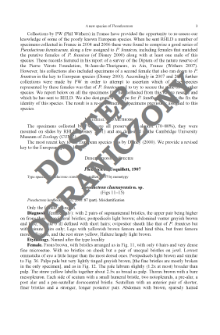- Search in all Repository
- Literature and maps
- Archeology
- Mills database
- Natural sciences
Advanced search
Advanced search
Advanced search
Advanced search
Advanced search

Object
Title: Phylogeny and classification of the family Lycidae (Insecta: Coleoptera)
Subtitle:
Annales Zoologici, vol. 58, no 4
Contributor:
Muzeum i Instytut Zoologii Polskiej Akademii Nauk
Publisher:
Place of publishing:
Description:
Bibliogr. p. 718-720 ; P. 695-720 : ill. ; 27 cm ; Taxa in Latin
Type of object:
Abstract:
Lycidae, net winged beetles, have proved difficult to classify using morphological characters. Here, using a previously published molecular phylogeny, comparing the results with morphological data and re-analyzing previously published morphological data set, we propose a revised classification of Lycidae. All analyses supportthe monophyly of Lycidae, but phylogeny inferred from molecular data is in conflict with the current classification. The adult larviform females evolved in several lineages andnever switched back to a winged form. Therefore, neotenic development of females is nota synapomorphy of Lycidae and the neotenic lineages do not form a basal paraphylum with respect to remaining Lycidae as previously proposed. As a consequence morphological similarities resulting from neoteny are homoplasies and cannot be used for definition of monophyletic lineages. The major result of this study is delineation of five basal clades, which are given subfamily rank: Libnetinae Bocak et Bocakova, 1990, stat. nov., Dictyopterinae Kleine, 1928, stat. nov., Lyropaeinae Bocak et Bocakova, 1989, Ateliinae Kleine, 1928 and Lycinae Laporte, 1836, sensu nov. Dexorinae Bocak et Bocakova, 1989, stat. nov. were not available for molecular analyses and their position is inferred from morphology alone. Further, Lycinae are redefined. Leptolycini are nested among Neotropical Lycini and render them paraphyletic. Slipinskiini are shown to group with Erotini. The distant position of Macrolycini and Dilophotini is demonstrated and Dilophotini are transferred from Calochrominae to Ateliinae. Four new tribes are proposed: Lycoprogenthini trib. nov. in Dictyopterinae, Alyculini trib. nov. and Antennolycini trib.nov. in Lyropaeinae, Dihammatini trib. nov. in Lycinae. Calochromini Lacordaire, 1857, stat. nov. and Leptolycini Leng et Mutchler, 1922, stat. nov. are lowered to the tribal statusin Lycinae. The validity of Thonalmini Kleine, 1933 stat. rev. is re-established.
Relation:
Volume:
Issue:
Start page:
End page:
Detailed Resource Type:
Format:
Resource Identifier:
Source:
MiIZ PAN, call no. P.255, vol 58, no 4 ; MiIZ PAN, call no. P.4314, vol 58, no 4 ; click here to follow the link
Language:
Language of abstract:
Rights:
Rights Reserved - Restricted Access
Terms of use:
Digitizing institution:
Museum and Institute of Zoology of the Polish Academy of Sciences
Original in:
Library of the Museum and Institute of Zoology of the Polish Academy of Sciences
Projects co-financed by:
Programme Innovative Economy, 2010-2014, Priority Axis 2. R&D infrastructure ; European Union. European Regional Development Fund
Access:
Object collections:
- Digital Repository of Scientific Institutes > Partners' collections > Museum and Institute of Zoology PAS > Scientific Journals
- Digital Repository of Scientific Institutes > Partners' collections > Museum and Institute of Zoology PAS > MIZ PAN Publications > Annales Zoologici
- Digital Repository of Scientific Institutes > Literature > Journals/Articles
Last modified:
Feb 4, 2025
In our library since:
May 5, 2016
Number of object content downloads / hits:
19
All available object's versions:
https://rcin.org.pl./publication/55765
Show description in RDF format:
Show description in RDFa format:
Show description in OAI-PMH format:
| Edition name | Date |
|---|---|
| Phylogeny and classification of the family Lycidae (Insecta: Coleoptera) / Bocák, Ladislav ; Bocáková, Milada | Feb 4, 2025 |
Objects Similar
Hammer, S. Nadlinger, K. Hartl, G. B.
Rutkowski, Robert Jagołkowska, Patrycja Mazgajski, Tomasz D. Rejt, Łukasz
Sidorowicz, J.
Czechowski, Wojciech Douwes, Per
Kilian, Aleksandra
Wiktor, Andrzej

 INSTYTUT ARCHEOLOGII I ETNOLOGII POLSKIEJ AKADEMII NAUK
INSTYTUT ARCHEOLOGII I ETNOLOGII POLSKIEJ AKADEMII NAUK
 INSTYTUT BADAŃ LITERACKICH POLSKIEJ AKADEMII NAUK
INSTYTUT BADAŃ LITERACKICH POLSKIEJ AKADEMII NAUK
 INSTYTUT BADAWCZY LEŚNICTWA
INSTYTUT BADAWCZY LEŚNICTWA
 INSTYTUT BIOLOGII DOŚWIADCZALNEJ IM. MARCELEGO NENCKIEGO POLSKIEJ AKADEMII NAUK
INSTYTUT BIOLOGII DOŚWIADCZALNEJ IM. MARCELEGO NENCKIEGO POLSKIEJ AKADEMII NAUK
 INSTYTUT BIOLOGII SSAKÓW POLSKIEJ AKADEMII NAUK
INSTYTUT BIOLOGII SSAKÓW POLSKIEJ AKADEMII NAUK
 INSTYTUT CHEMII FIZYCZNEJ PAN
INSTYTUT CHEMII FIZYCZNEJ PAN
 INSTYTUT CHEMII ORGANICZNEJ PAN
INSTYTUT CHEMII ORGANICZNEJ PAN
 INSTYTUT FILOZOFII I SOCJOLOGII PAN
INSTYTUT FILOZOFII I SOCJOLOGII PAN
 INSTYTUT GEOGRAFII I PRZESTRZENNEGO ZAGOSPODAROWANIA PAN
INSTYTUT GEOGRAFII I PRZESTRZENNEGO ZAGOSPODAROWANIA PAN
 INSTYTUT HISTORII im. TADEUSZA MANTEUFFLA POLSKIEJ AKADEMII NAUK
INSTYTUT HISTORII im. TADEUSZA MANTEUFFLA POLSKIEJ AKADEMII NAUK
 INSTYTUT JĘZYKA POLSKIEGO POLSKIEJ AKADEMII NAUK
INSTYTUT JĘZYKA POLSKIEGO POLSKIEJ AKADEMII NAUK
 INSTYTUT MATEMATYCZNY PAN
INSTYTUT MATEMATYCZNY PAN
 INSTYTUT MEDYCYNY DOŚWIADCZALNEJ I KLINICZNEJ IM.MIROSŁAWA MOSSAKOWSKIEGO POLSKIEJ AKADEMII NAUK
INSTYTUT MEDYCYNY DOŚWIADCZALNEJ I KLINICZNEJ IM.MIROSŁAWA MOSSAKOWSKIEGO POLSKIEJ AKADEMII NAUK
 INSTYTUT PODSTAWOWYCH PROBLEMÓW TECHNIKI PAN
INSTYTUT PODSTAWOWYCH PROBLEMÓW TECHNIKI PAN
 INSTYTUT SLAWISTYKI PAN
INSTYTUT SLAWISTYKI PAN
 SIEĆ BADAWCZA ŁUKASIEWICZ - INSTYTUT TECHNOLOGII MATERIAŁÓW ELEKTRONICZNYCH
SIEĆ BADAWCZA ŁUKASIEWICZ - INSTYTUT TECHNOLOGII MATERIAŁÓW ELEKTRONICZNYCH
 MUZEUM I INSTYTUT ZOOLOGII POLSKIEJ AKADEMII NAUK
MUZEUM I INSTYTUT ZOOLOGII POLSKIEJ AKADEMII NAUK
 INSTYTUT BADAŃ SYSTEMOWYCH PAN
INSTYTUT BADAŃ SYSTEMOWYCH PAN
 INSTYTUT BOTANIKI IM. WŁADYSŁAWA SZAFERA POLSKIEJ AKADEMII NAUK
INSTYTUT BOTANIKI IM. WŁADYSŁAWA SZAFERA POLSKIEJ AKADEMII NAUK


































